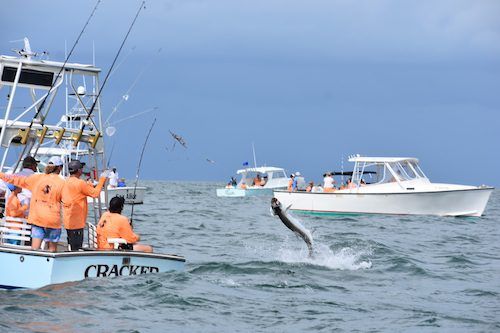Tarpon and snook catch $1.2 million research grant

Increasing development and the importance of local tarpon and snook populations have spurred a $1.2 million grant from the National Oceanic and Atmospheric Administration (NOAA) that will specifically target Charlotte Harbor.
“These are very specific needs of a very specific fish,” said Nicole Iadevaia, director of research and restoration for the Coastal & Heartland National Estuary Partnership. CHNEP is working on the project with a team that includes the Bonefish and Tarpon Trust, Florida’s Fish and Wildlife Conservation Commission and Charlotte County government.
The study is unique in that it takes into consideration economic development, and asks for “realistic options for implementing habitat protection or restoration.” It is officially titled “Implementation of a research plan to guide decisions on place-based recreational fishery conservation in Charlotte Harbor.”
The $1,287,506 project officially began November 1. In the project, they will catalog and observe “essential nursery habitats” of snook and tarpon across all of Charlotte Harbor. Of greatest interest will be habitats vulnerable to urban development and without current protection.
The five-year project will not only identify the locations, but because it is cosponsored by state and county governments, it will provide that information to for use in government mapping and modeling through GIS maps. It will not implement any policies, and it will incorporate the work of other nongovernmental organations.
“There will be public policy recommendations coming out of this,” said Iadevaia. “They can incorporate this in their urban use plans.”
The grant is not just about a few species of fish, but creating a process where economically important ecology can be formally considered. The process can then be used for other jurisdictions and species. Part of that plan is a “Vulnerable Index” for use in land use planning departments. The mapping of data on habitat can be overlaid with data on potential development, freshwater flows and ownership of land. The index is a decision-making tool to prioritize not only the how of protecting habitat, but the locations for restoration, and doing so in a way that is economically effective.
“Once this ‘VI’ is in place, we plan to expand to other regions in the state where sportfish nursery habitat is at risk,” said Iadevia. “There is an economic side to protecting habitat. It’s economically valuable but also ecologically important.”
Many of the areas surveyed are already wetlands, some already protected. The project will attempt to define more carefully what sort of wetlands the tarpon need.
The Award and Economics
The award is part of a $16.8 million package that will be disbursed to 32 organizations working across 10 projects in the Gulf of Mexico. Each of the projects is about actionable research that can be implemented, such as habitat restoration.
Overall, natural resources in the Charlotte Harbor region generate more than $13.6 billion in total output, $3.8 billion in regional income, $146 million in local and state tax revenues, and support more than 148,000 jobs annually.
“We want to know what is the ideal habitat,” said Iadevia. “Part of that is getting to find more of these habitats.”
Because the project is based on the premise that sport fishing is important to the why of people being in this area, they hope that they can convey to the public how they can be a part of the recovery.
“There is going to be a big outreach component,” said Iadevia.
For instance, when the areas are identified, the spawning areas would be seen as a positive in a housing development plan, not a negative. Neighborhoods could then be able to say they are a “tarpon-safe neighborhood.”
The relationship building will include confidentially gathering information from those who fish the water and know it best.
The genesis of the NOAA Restore Science program was the BP Deepwater Horizon oil spill. The “Restore” in the program is actually an acronym, namely the “Resources and Ecosystems Sustainability, Tourist Opportunities, and Revived Economies” of the Gulf Coast States Act of 2012. Congress set out that the grants would not just be about science, but involve observation, monitoring and technology, with a strong public component.
“It’s where all the science comes together,” said Iadevia.
The plan will also have the time and scope to understand areas that are difficult to access.
“Part of that is getting to find more of these habitats, to protect these areas before they are developed,” said Iadevia.








